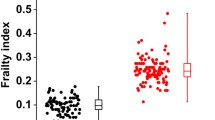Abstract
Mutations that are supposed to affect right (RV) and left ventricular (LV) electrophysiology equally, often reveal dominant conduction slowing and arrhythmia vulnerability in RV. In this study we investigated the mechanism of dominant arrhythmia vulnerability of RV in senescent mice. We performed epicardial ventricular activation mapping on adult and senescent Langendorff perfused hearts. Longitudinal and transversal conduction velocity, as well as arrhythmia inducibility were determined. Subsequently, hearts were processed for immunohisto-chemistry and Picro Sirius Red staining. Senescent mice revealed decreased conduction velocity, increased aniso-tropic ratio and reduced excitation wavelength in RV, but not in LV. Arrhythmias were mainly induced in RV of senescent hearts. No arrhythmias were induced in adult hearts. Immunohistochemistry revealed that the amount of Connexin 43 and cardiac sodium channel Nav1 .5 were equally decreased, and that collagen content was equally increased in senescent RV and LV. However, patches of replacement fibrosis were found throughout the RV wall, but only in the sub-endocardium and mid-myocardium of LV. The study shows that the dominant arrhythmia vulnerability in RV of senescent mice is caused by the distribution of replacement fibrosis which involves the entire RV but only part of the LV. (Neth Heart J 2008; 16:356-8.)
Similar content being viewed by others
References
Antzelevitch C. Brugada syndrome. Pacing Clin Electrophysiol 2006;29: 1130-59.
Kies P, Bootsma M, Bax J, et al. Arrhythmogenic right ventricular dysplasia/cardiomyopathy: screening, diagnosis, and treatment. Heart Rhythm 2006;3:225-34.
van Rijen HV, Eckardt D, Degen J, et al. Slow conduction and enhanced anisotropy increase the propensity for ventricular tachyarrhythmias in adult mice with induced deletion of connexin43. Circulation 2004;109:1048-55.
van Veen TA, Stein M, Royer A, et al. Impaired impulse propagation in Scn5a-knockout mice: combined contribution of excitability, connexin expression, and tissue architecture in relation to aging. Circulation 2005; 112:1927-35.
De Mello WC. Beneficial effect of eplerenone on cardiac remodelling and electrical properties of the failing heart. J Renin Angiotensin Aldosterone Syst 2006;7:40-6.
Author information
Authors and Affiliations
Corresponding author
Additional information
Department of Medical Physiology, Division Heart and Lungs, University Medical Center Utrecht, Utrecht, and Interuniversity Cardiology Institute of the Netherlands, Utrecht, the Netherlands
Department of Medical Physiology, Division Heart and Lungs, University Medical Center Utrecht, Utrecht, the Netherlands
Department of Medical Physiology, Division Heart and Lungs, University Medical Center Utrecht, Utrecht, Interuniversity Cardiology Institute of the Netherlands, Utrecht, and Heart Failure Research Center, Academic Medical Center Amsterdam, the Netherlands
Departments of Medical Physiology and Cardiology, Division Heart and Lungs, University Medical Center Utrecht, Utrecht, the Netherlands
Correspondence to: H.V.M. van Rijen Department of Medical Physiology, Division Heart and Lungs, University Medical Center Utrecht, Yalelaan 50, 3584 CM Utrecht, the Netherlands
Rights and permissions
About this article
Cite this article
Noorman, M., van Rijen, H.V.M., van Veen, T.A.B. et al. Differences in distribution of fibrosis in the ventricles underlie dominant arrhythmia vulnerability of the right ventricle in senescent mice. NHJL 16, 356–358 (2008). https://doi.org/10.1007/BF03086178
Issue Date:
DOI: https://doi.org/10.1007/BF03086178




